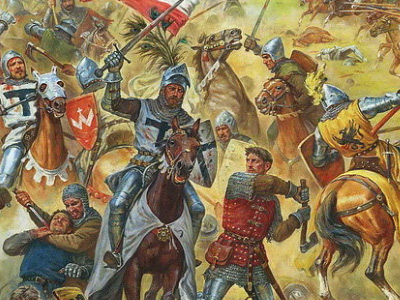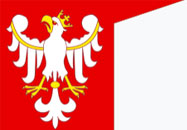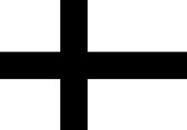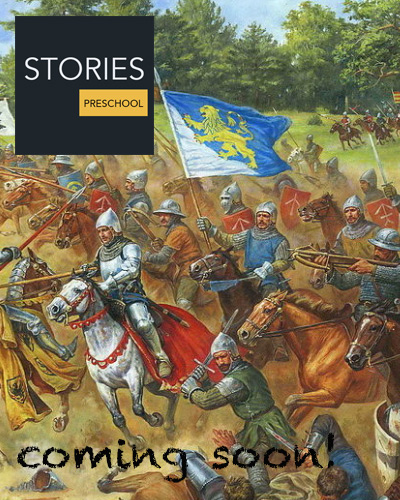Battle of Grunwald (1410)
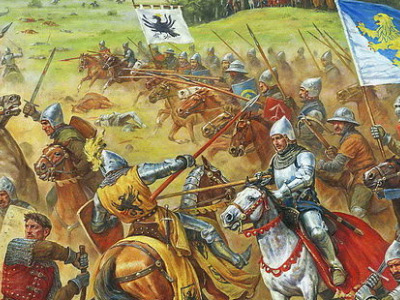
Opposing Forces
The precise number of soldiers involved has proven difficult to establish. None of the contemporary sources provided reliable troop counts. Jan Długosz provided the number of banners, the principal unit of each cavalry: 51 for the knights, 50 for the Poles and 40 for the Lithuanians. However, it is unclear how many men were under each banner. The structure and number of infantry units (pikemen, archers, crossbowmen) and artillery units is unknown. Estimates, often biased by political and nationalistic considerations, were produced by various historians. German historians tend to present lower numbers, while Polish historians tend to use higher estimates. The high-end estimates by Polish historian Stefan Kuczyński of 39,000 Polish–Lithuanian and 27,000 Teutonic men have been cited in Western literature as "commonly accepted".
While less numerous, the Teutonic The Teutonic Order is a Catholic religious institution founded as a military society c. 1190 in Acre, Kingdom of Jerusalem. The Order of Brothers of the German House of Saint Mary in Jerusalem was formed to aid Christians on their pilgrimages to the Holy Land and to establish hospitals. Its members have commonly been known as the Teutonic Knights, having a small voluntary and mercenary military membership, serving as a crusading military order for the protection of Christians in the Holy Land and the Baltics during the Middle Ages. army had advantages in discipline, military training and equipment. They were particularly noted for their heavy cavalry. The Teutonic army was also equipped with bombards that could shoot lead and stone projectiles. Both forces were composed of troops from several states and lands, including numerous mercenaries; for example, Bohemian mercenaries fought on each side. The knights also invited guest crusaders. Twenty-two different peoples, mostly Germanic, joined them. Teutonic recruits included soldiers from Westphalia, Frisia, Austria
The Teutonic Order is a Catholic religious institution founded as a military society c. 1190 in Acre, Kingdom of Jerusalem. The Order of Brothers of the German House of Saint Mary in Jerusalem was formed to aid Christians on their pilgrimages to the Holy Land and to establish hospitals. Its members have commonly been known as the Teutonic Knights, having a small voluntary and mercenary military membership, serving as a crusading military order for the protection of Christians in the Holy Land and the Baltics during the Middle Ages. army had advantages in discipline, military training and equipment. They were particularly noted for their heavy cavalry. The Teutonic army was also equipped with bombards that could shoot lead and stone projectiles. Both forces were composed of troops from several states and lands, including numerous mercenaries; for example, Bohemian mercenaries fought on each side. The knights also invited guest crusaders. Twenty-two different peoples, mostly Germanic, joined them. Teutonic recruits included soldiers from Westphalia, Frisia, Austria Austria, formally the Republic of Austria, is a country in the southern part of Central Europe, lying in the Eastern Alps. After the dissolution of the Holy Roman Empire in 1806, Austria established its own empire, which became a great power and the dominant member of the German Confederation. The empire's defeat in the Austro-Prussian War of 1866 led to the end of the Confederation and paved the way for the establishment of Austria-Hungary a year later., Swabia and Stettin (Szczecin). Two Hungarian nobles, Nicholas II Garay and Stibor of Stiboricz, brought 200 men for the Knights, but support from Sigismund of Hungary was disappointing.
Austria, formally the Republic of Austria, is a country in the southern part of Central Europe, lying in the Eastern Alps. After the dissolution of the Holy Roman Empire in 1806, Austria established its own empire, which became a great power and the dominant member of the German Confederation. The empire's defeat in the Austro-Prussian War of 1866 led to the end of the Confederation and paved the way for the establishment of Austria-Hungary a year later., Swabia and Stettin (Szczecin). Two Hungarian nobles, Nicholas II Garay and Stibor of Stiboricz, brought 200 men for the Knights, but support from Sigismund of Hungary was disappointing.
Poland brought mercenaries from Moravia and Bohemia. The Czechs produced two full banners, under the command of Jan Sokol of Lamberk. Serving among the Czechs was possibly Jan Žižka, future commander of the Hussite forces. Alexander the Good, ruler of Moldavia, commanded an expeditionary corps. Vytautas gathered troops from Lithuanian, Ruthenian (modern Belarus and Ukraine Ukraine is a country in Eastern Europe. It is the second-largest European country after Russia, which it borders to the east and northeast. Kyiv, also spelled Kiev, is the capital and most populous city of Ukraine. It is in north-central Ukraine along the Dnieper River. On 24 February 2022, Russia invaded Ukraine in a major escalation of the Russo-Ukrainian War that began in 2014.) and Russian lands. The three Russian banners from Smolensk were under the command of Władysław II Jagiełło's brother Lengvenis, while the contingent of Tatars of the Golden Horde was under the command of the future Khan Jalal ad-Din. The overall commander of the joint Polish–Lithuanian force was King Władysław II Jagiełło; however, he did not directly participate in the battle. The Lithuanian units were commanded directly by Grand Duke Vytautas, who was second in command, and helped design the grand strategy of the campaign. Vytautas actively participated in the battle, managing both Lithuanian and Polish units. Jan Długosz stated that the low-ranking sword bearer of the Crown, Zyndram of Maszkowice, commanded the Polish army, but that is highly doubtful. More likely, marshal of the Crown Zbigniew of Brzezie commanded the Polish troops in the field.
Ukraine is a country in Eastern Europe. It is the second-largest European country after Russia, which it borders to the east and northeast. Kyiv, also spelled Kiev, is the capital and most populous city of Ukraine. It is in north-central Ukraine along the Dnieper River. On 24 February 2022, Russia invaded Ukraine in a major escalation of the Russo-Ukrainian War that began in 2014.) and Russian lands. The three Russian banners from Smolensk were under the command of Władysław II Jagiełło's brother Lengvenis, while the contingent of Tatars of the Golden Horde was under the command of the future Khan Jalal ad-Din. The overall commander of the joint Polish–Lithuanian force was King Władysław II Jagiełło; however, he did not directly participate in the battle. The Lithuanian units were commanded directly by Grand Duke Vytautas, who was second in command, and helped design the grand strategy of the campaign. Vytautas actively participated in the battle, managing both Lithuanian and Polish units. Jan Długosz stated that the low-ranking sword bearer of the Crown, Zyndram of Maszkowice, commanded the Polish army, but that is highly doubtful. More likely, marshal of the Crown Zbigniew of Brzezie commanded the Polish troops in the field.
HISTORY
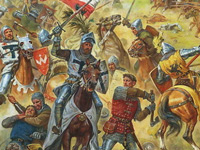
RESOURCES
This article uses material from the Wikipedia article "Battle of Grunwald (1410)", which is released under the Creative Commons Attribution-Share-Alike License 3.0.
© Stories Preschool. All Rights Reserved.
